This was published 8 years ago
Nagasaki, Japan: The other side to Japan's Atomic Bomb City
By Brian Johnston
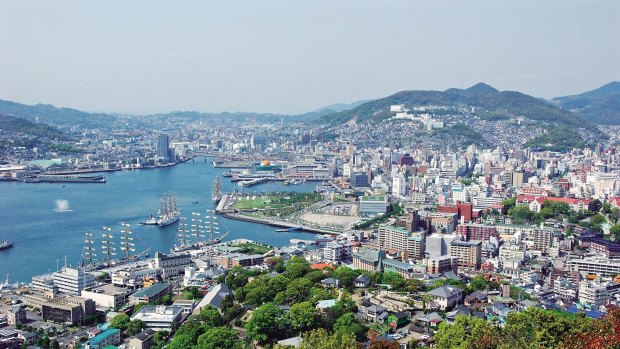
The beautiful views over Nagasaki.
The approach to Nagasaki is beautiful in the early morning as my Ponant cruise ship L'Austral glides through the silent, silvery-grey water of a bay fringed by forested hills. Humped islands are draped in gossamer mist and seabirds drift. Like a seven-veiled dance, the city is revealed in slow instalments: villas half concealed in trees, bridges, houses tumbling down hillsides.
Then we glide past the Mitsubishi shipyards that made this city a target for American bombing in World War II, and the city is revealed. Locals jog on the promenade and trams rumble along the road. Beyond stand colonial-era buildings that wouldn't look out of place in downtown Melbourne. This subversion of stereotypes is what I enjoy most about travel. Before I've even left the ship's deck, my perception of Nagasaki as just That Atomic Bomb City is already cracking.
"Fat Boy" was dropped on Nagasaki in the late morning of 9 August 1945. It missed the Mitsubishi shipyards by 800 metres, flattened a third of the city and killed 73,884 people outright, injuring as many more. The first stop on our shore excursion is the Atomic Bomb Museum, with its unflinching portrayal of destruction and death. To me, however, it turns out to be far from the most interesting thing about Nagasaki.
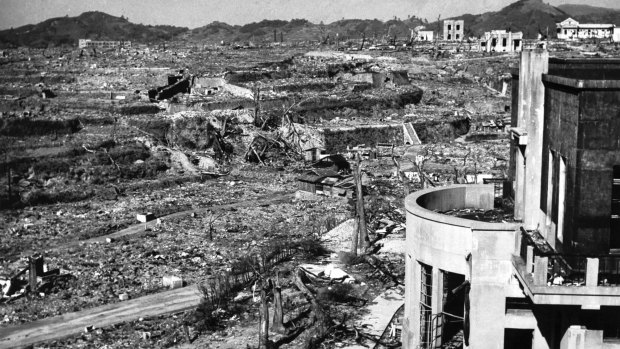
A totally destroyed Nagasaki in 1945.Credit: Getty Images
What did I expect before I floated into this harbour city? Bombed out ruins and disfigured people, perhaps. Nonsense, of course. Seventy years on, you'd never know Nagasaki was obliterated in an instant. Its ordinariness is almost shocking. The city of 440,000 people thrives on maritime trade, shipbuilding, fish and mostly domestic tourism. Like any other city, its downtown is a jostle of office blocks, department stores, temples and noodle houses. More laid-back and less neon-encrusted than many Japanese cities, Nagasaki has a rather sleepy seaside charm.
Japanese tourists (apart from herds of baffled, fidgeting schoolkids) don't come for the Atomic Bomb Museum but for Nagasaki's air of foreignness. Long before it became notorious, the city was an east-west trading and missionary outpost. The Portuguese came in 1571 but where booted out for their meddlesome Catholicism. Only the Dutch remained after 1639, running the only European trading post in all Japan through its two centuries of seclusion.
Tiny Dejima Island that confined the foreigners is now joined to the mainland by reclamation, and swallowed up into Nagasaki's workaday harbour area. Its restored or re-created Dutch houses are pleasant but bland, providing a desultory poke around old cannon, sundials and telescopes. Japanese tourists have more fun in Huis Ten Bosch, a re-created 17th-century Dutch town complete with royal palaces, windmills and clog-hopping tulip-growers, but it's 65 kilometres out of town.
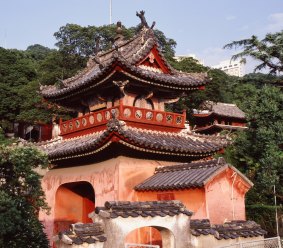
The Sofuku-ji Chinese temple in the hills above Nagasaki. Credit: Brian Johnston
For those off a cruise ship, better walk across the canal and into Chinatown, that other little historical enclave of allowable foreignness. It still has a lived-in bustle and clutter. Shopkeepers fry octopus under grinning gilt dragons, schoolgirls gorge on steamed buns, and tourists browse for trinkets. The hills above town are dotted with Chinese temples. Kofuku-ji is the most pleasant, with leafy gardens and lazy views, but I like Sofuku-ji, a knobbly orange Zen temple that looks as if it might have been dreamed up by a Chinese Dr Seuss.
The hills are Nagasaki's highlight, providing the harbour with its undulating landscape and the town with another layer of history. When Japan was finally, forcibly opened to Western trade by American gunboats in 1853, European traders moved in. They set up their villas on these breezy heights and turned the hills into a suburban Southampton. The Glover Gardens area where some villas still stand, and where others have been relocated, is a not-to-be-missed delight. Views showcase Nagasaki's voluptuous, hill-ringed harbour setting.
The first landmark is Oura Church, a skinny white Catholic edifice at the top of a flight of steps, pretty with stained glass inside. Beyond are clapboard or brick mansions on grounds bright with flowerbeds. Glover Villa is the oldest Western-style building in Japan (1863), and the district also boasts Japan's first paved road and first tennis court. Japanese visitors love it for its pretty packaged history: a visit to Europe without leaving the homeland.
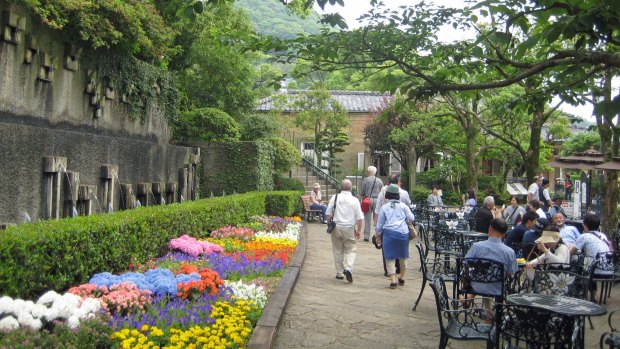
The colonial-era Glover Gardens district in Nagasaki.Credit: Brian Johnston
Information panels at many of the houses, whose interiors are open for a stickybeak, give good explanations of the rollicking lifestyles of Nagasaki's 19th-century European traders. Chief exhibit: Scotsman Thomas Glover, who built a large house, established beer production in Japan (Kirin is now one of the nation's largest breweries), connived in overthrowing a shogun and married a geisha. His love story is said to have inspired Puccini to set his opera Madama Butterfly in Nagasaki.
Fortunately my Ponant cruise ship has berthed just below Glover Gardens, allowing me an easy revisit once my shore-excursion overview is complete. It's the kind of place I like, a culture within a culture. Nagasaki has been unexpected in other ways too. It's no longer just a place where an atomic bomb fell, even if I'll always remember its museum exhibits: the bones of a human hand melted into a bottle, the charred lunchbox of schoolgirl Satoko Tsutsumi filled with blackened rice. It has become a city with a bigger story, and forever changed in my perception.
TRIP NOTES
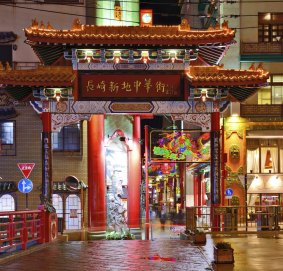
The Chinatown district Nagasaki established in the 15th century.Credit: iStock
MORE INFORMATION
www.travel.at-nagasaki.jp and www.jnto.org.au
GETTING THERE
Japan Airlines flies from Melbourne and Sydney to Nagasaki via Tokyo. Phone 1300 525 287, see www.au.jal.com
CRUISING THERE
Ponant's 'Best of Japan' cruise visits Nagasaki on its eight-night itineraries around southern Japan (and Pusan in Korea) between Maizuru and Osaka. It spends a full day in port, which can be explored on optional shore excursions or individually. Prices from $3780pp. Phone 1300 737 178, see www.ponant.com
STAYING THERE
If you aren't cruising, stay at traditional Japanese inn Sakamoto-ya, which has attentive service and includes breakfast and dinner. Phone +81 95 826 8211, see www.sakamotoya.co.jp
The writer travelled courtesy of Ponant.
Sign up for the Traveller Deals newsletter
Get exclusive travel deals delivered straight to your inbox. Sign up now.